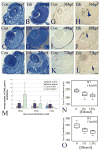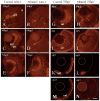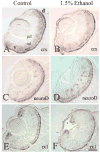Mechanisms for persistent microphthalmia following ethanol exposure during retinal neurogenesis in zebrafish embryos
- PMID: 17640445
- PMCID: PMC2583023
- DOI: 10.1017/S0952523807070423
Mechanisms for persistent microphthalmia following ethanol exposure during retinal neurogenesis in zebrafish embryos
Abstract
The exposure of the developing human embryo to ethanol results in a spectrum of disorders involving multiple organ systems, including the visual system. One common phenotype seen in humans exposed to ethanol in utero is microphthalmia. The objective of this study was to describe the effects of ethanol during retinal neurogenesis in a model organism, the zebrafish, and to pursue the potential mechanisms by which ethanol causes microphthalmia. Zebrafish embryos were exposed to 1% or 1.5% ethanol from 24 to 48 h after fertilization, a period during which the retinal neuroepithelium undergoes rapid proliferation and differentiation to form a laminated structure composed of different retinal cell types. Ethanol exposure resulted in significantly reduced eye size immediately following the treatment, and this microphthalmia persisted through larval development. This reduced eye size could not entirely be accounted for by the accompanying general delay in embryonic development. Retinal cell death was only slightly higher in ethanol-exposed embryos, although cell death in the lens was extensive in some of these embryos, and lenses were significantly reduced in size as compared to those of control embryos. The initiation of retinal neurogenesis was not affected, but the subsequent waves of cell differentiation were markedly reduced. Even cells that were likely generated after ethanol exposure--rod and cone photoreceptors and Müller glia--were delayed in their expression of cell-specific markers by at least 24 h. We conclude that ethanol exposure over the time of retinal neurogenesis resulted in persistent microphthalmia due to a combination of an overall developmental delay, lens abnormalities, and reduced retinal cell differentiation.
Figures







Similar articles
-
Ethanol-induced microphthalmia is not mediated by changes in retinoic acid or sonic hedgehog signaling during retinal neurogenesis.Alcohol Clin Exp Res. 2011 Sep;35(9):1644-61. doi: 10.1111/j.1530-0277.2011.01511.x. Epub 2011 May 9. Alcohol Clin Exp Res. 2011. PMID: 21554333 Free PMC article.
-
Effects of ethanol on photoreceptors and visual function in developing zebrafish.Invest Ophthalmol Vis Sci. 2006 Oct;47(10):4589-97. doi: 10.1167/iovs.05-0971. Invest Ophthalmol Vis Sci. 2006. PMID: 17003456 Free PMC article.
-
Molecular and morphological changes in zebrafish following transient ethanol exposure during defined developmental stages.Neurotoxicol Teratol. 2014 Jul-Aug;44:70-80. doi: 10.1016/j.ntt.2014.06.001. Epub 2014 Jun 11. Neurotoxicol Teratol. 2014. PMID: 24929233 Free PMC article.
-
Characterization of Müller glia and neuronal progenitors during adult zebrafish retinal regeneration.Exp Eye Res. 2008 Nov;87(5):433-44. doi: 10.1016/j.exer.2008.07.009. Epub 2008 Aug 5. Exp Eye Res. 2008. PMID: 18718467 Free PMC article.
-
Proneural gene ash1 promotes amacrine cell production in the chick retina.Dev Neurobiol. 2009 Feb 1-15;69(2-3):88-104. doi: 10.1002/dneu.20693. Dev Neurobiol. 2009. PMID: 19067322 Free PMC article.
Cited by
-
Diving into the world of alcohol teratogenesis: a review of zebrafish models of fetal alcohol spectrum disorder.Biochem Cell Biol. 2018 Apr;96(2):88-97. doi: 10.1139/bcb-2017-0122. Epub 2017 Aug 17. Biochem Cell Biol. 2018. PMID: 28817785 Free PMC article. Review.
-
Fetal alcohol spectrum disorders: Zebrafish in the analysis of the milder and more prevalent form of the disease.Behav Brain Res. 2018 Oct 15;352:125-132. doi: 10.1016/j.bbr.2017.10.005. Epub 2017 Oct 5. Behav Brain Res. 2018. PMID: 28988969 Free PMC article. Review.
-
Discovering Novel Bioactivities of Controversial Food Additives by Means of Simple Zebrafish Embryotoxicity (ZET) Assays.Toxics. 2022 Dec 22;11(1):8. doi: 10.3390/toxics11010008. Toxics. 2022. PMID: 36668734 Free PMC article.
-
Analysis of crosstalk between retinoic acid and sonic hedgehog pathways following ethanol exposure in embryonic zebrafish.Birth Defects Res A Clin Mol Teratol. 2015 Dec;103(12):1046-57. doi: 10.1002/bdra.23460. Epub 2015 Oct 16. Birth Defects Res A Clin Mol Teratol. 2015. PMID: 26470995 Free PMC article.
-
Inhibition of ecto-5'-nucleotidase and adenosine deaminase is able to reverse long-term behavioural effects of early ethanol exposure in zebrafish (Danio rerio).Sci Rep. 2020 Oct 20;10(1):17809. doi: 10.1038/s41598-020-74832-0. Sci Rep. 2020. PMID: 33082435 Free PMC article.
References
-
- Arenzana FJ, Carvan MJ, 3rd, Aijon J, Sanchez-Gonzalez R, Arevalo R, Porteros A. Teratogenic effects of ethanol exposure on zebrafish visual system development. Neurotoxicology and Teratology. 2006;28:342–348. - PubMed
-
- Barthel LK, Raymond PA. Subcellular localization of alpha-tubulin and opsin mRNA in the goldfish retina using digoxigenin-labeled cRNA probes detected by alkaline phosphatase and HRP histochemistry. Journal of Neuroscience Methods. 1993;50:145–152. - PubMed
-
- Biehlmaier O, Neuhauss SC, Kohler K. Onset and time course of apoptosis in the developing zebrafish retina. Cell Tissue Research. 2001;306:199–207. - PubMed
-
- Bilotta J, Barnett JA, Hancock L, Saszik S. Ethanol exposure alters zebrafish development: A novel model of fetal alcohol syndrome. Neurotoxicology and Teratology. 2004;26:737–743. - PubMed
Publication types
MeSH terms
Substances
Grants and funding
LinkOut - more resources
Full Text Sources
Molecular Biology Databases

